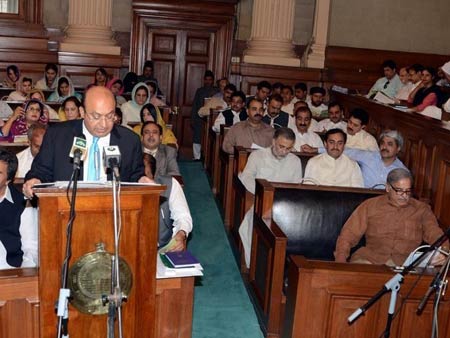Inflated agriculture budget
By
Ahmad Fraz Khan
 THE
Punjab’s agriculture budget has turned out to be the way, it
should not have been — a pack of contradictions, which are
too glaring to be missed by even a naive farmer.
THE
Punjab’s agriculture budget has turned out to be the way, it
should not have been — a pack of contradictions, which are
too glaring to be missed by even a naive farmer.
To begin with, the budgetary allocation of Rs5 billion is a
contradiction in itself, given four years record of the
present government. Ever since this government came into
power in 2008, it has never spent the entire budgetary
allocation on the sector.
Why it keeps increasing the figure every year, to be slashed
later? It needs to explain. For example, it allocated Rs2.8
billion in 2007-08 but later revised it to a paltry Rs917
million — almost 75 per cut on original allocation for the
sector.
Similarly, in 2008-9, it allocated Rs3 billion for the
sector, but later reduced it down to Rs2.2 billion. Next
year, the allocation was even higher at Rs3.2 billion as the
reduction became much heavier with only Rs1.5 billion
actually released — a drop of more than 50 per cent.
This year, it has set aside Rs5 billion — an increase of
almost 146 per cent. Should farmers believe that it was
sincere in spending it too? If it does spend the amount, it
would actually be more than 300 per cent increase in
spending over the last year.
The Punjab government needs to explain two things: what has
increased its capacity to absorb that kind of money? Second,
why it perfunctorily keeps increasing allocation figure when
it does not intend to spend it?
Most of the budget would be under four heads — water
conservation, bio-gas development, supply chain improvement
and tractors subsidy. Of all four areas, water management
makes the most interesting reading. The project of water
courses lining is almost six-year old and the biggest of
them all. Every year, allocations are made for lining of
water courses without assessing what harm or benefit it has
brought to the province. If it has saved, or restored — as
claimed by the proponents of the project — where has that
water gone. It needs to be studied.
To make the strategy even more questionable, cemented floors
are being built to stop water seepage to the ground in a
province where one million tube-wells are continuously
pumping water out of soil. These tube-wells pump around 35
million acre feet water every year. Take it in the backdrop
of 53maf supplies that the province draws from canals, the
figure becomes
astonishing: Over 70 per cent of provincial supplies come
from the soil.
On the one hand, the government is allowing these tube-wells
to pump 35 million acre feet of water out of subsoil
storage. And, on the other, it is allocating massive amounts
to stop water seepage to replenish aquifer. Does anyone in
official circles see the disconnect between both these
policies? Or, does it seem to be a sustainable option?
There is yet another disconnect. For the last few years, the
Punjab government has refused to pay its part of the subsidy
bill on tube-wells. It has been doing so on the ground that
these tube-wells are pumping massive amount of water and
playing havoc with aquifer. It refused to listen to farmers
and the federal government on the issue, and has not been
paying money that has now gone beyond Rs5 billion. On the
other, it has made allocations for subsidising conversion of
tube-well on bio-gas. In its energy sector head, it has paid
even more money to find solar solutions for the tube-wells.
These policy disconnects prove that different departments
and wings of Punjab are working “completely independent of
each other — without any coherent policy framework.” One
department does not know what the others are doing, and each
of them is only concentrating on its narrow mandate, without
assessing the impact of its work on others. Punjab needs to
have an integrated set of policies with an overall vision.
Another emerging counter-productive policy instrument is the
tractor subsidy. Punjab has earmarked another Rs2 billion
for subsidising tractors this year as well. For the last few
years, the entire provincial focus has shifted to tractors —
ignoring all other forms of machines. It is thus leading to
use of tractors in fields, rather than mechanisation. The
province already has around 400,000 tractors that make 0.6
horse-powers per acre — against 0.5hp average in other
developing countries. But still, both federal and provincial
governments are sticking to tractor subsidy for political
reasons — trying to out do each other.
This policy has entered a stage that could be
counter-productive now. Tractors are already sold on premier
price, whereas subsidies normally make sense on machines
that farmers do not buy, but are necessary for the health of
the soil.
Without other machines that help in preliminary and primary
tilling, ridging, sowing, inter-culture, harvesting,
spraying etc, the use of tractors becomes grossly
counter-productive: creating a hard pan and compacting soil.
So, it is time for the Punjab government to branch out:
promote other machines that take farmers towards
mechanisation.
It is not meant here to belittle importance of these
initiatives that make their own contributions to provincial
economy and farmers wellbeing but only to suggest that they
should compliment each other rather. Only by doing so, the
provincial government would look in-charge of the sector,
and planning for its betterment.
Courtesy: The DAWN